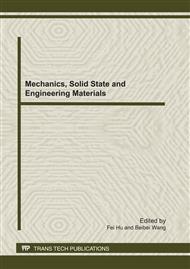[1]
H. J.M. Bouwmeester: Dense ceramic membranes for methane conversion. Catal. Today, Vol.82 (2003), pp.141-150.
DOI: 10.1016/s0920-5861(03)00222-0
Google Scholar
[2]
A. Tavolaro and P.Tavolaro: The preparation of transition metal-containing mordenite catalytic tubular composite membranes. Catal.Commun. Vol.10 (2008), pp.586-591.
DOI: 10.1016/j.catcom.2008.10.041
Google Scholar
[3]
A. Thursfield and I. S. Metcalfe: The use of dense mixed ionic and electronic conducting membranes for chemical production. J. Mater. Chem. Vol.14(2004), pp.2475-2485.
DOI: 10.1039/b405676k
Google Scholar
[4]
G.Henrici-Olive and S.Olive: The Fischer-Tropsch Synthesis: Molecular Weight Distribution of Primary Products and Reaction Mechanism. Angew.Chem.Int.Ed.Engl. Vol.15 (1976), pp.136-141.
DOI: 10.1002/anie.197601361
Google Scholar
[5]
W. Jin et al.: Tubular lanthanum cobaltite perovskite-type membrane reactors for partial oxidation of methane to syngas. J. Membr. Sci. Vol. 166 (2000), pp.13-22.
DOI: 10.1016/s0376-7388(99)00245-8
Google Scholar
[6]
U. Balachandran and J.T. Dusek: Dense ceramic membranes for partial oxidation of methane to syngas. Appl. Catal. A Vol.133 (1995), pp.19-29.
DOI: 10.1016/0926-860x(95)00159-x
Google Scholar
[7]
Z.P. Shao et al.:Investigation on the permeation behavior and stability of a Ba0.5Sr0.5Co0.8Fe0.2O3−δ oxygen membrane. J. Membr.Sci. Vol. 172 (2000), pp.177-188.
DOI: 10.1007/s12034-009-0059-z
Google Scholar
[8]
Z.P. Shao et al.: Performance of a mixed-conducting ceramic membrane reactor with high oxygen permeability for methane conversion. J. Membr. Sci. Vol. 183 (2001), pp.181-192.
DOI: 10.1016/s0376-7388(00)00591-3
Google Scholar
[9]
H.H. Wang, Y. Cong and W.S. Yang: Oxidative coupling of methane in Ba0.5Sr0.5Co0.8Fe0.2O3−δ tubular membrane reactors. Catal. Today, Vol. 104 (2005), pp.160-167.
DOI: 10.1016/j.cattod.2005.03.079
Google Scholar
[10]
Z.G. Shen, P.X. Lu and X. Hu: Improving the oxygen permeability of Ba0.5Sr0.5Co0.8Fe0.2O3-δ membranes by laser ablation. J. Inorg. Mater. Vol. 2 (2010), pp.221-224.
Google Scholar
[11]
X. Qi, F. T. Akin and Y. S. Lin: Ceramic–glass composite high temperature seals for dense ionic-conducting ceramic membranes. J. Membr. Sci. Vol. 193 (2001), pp.185-193.
DOI: 10.1016/s0376-7388(01)00488-4
Google Scholar
[12]
J.M. Wei et al.: Highly active and stable Ni/ZrO2 catalyst for syngas production by CO2 reforming of methane. Appl. Catal. A, Vol.196 (2000) pp.167-172.
DOI: 10.1016/s0926-860x(99)00504-9
Google Scholar
[13]
F. Meriche et al.: Micro structuring of LiNbO3 by using nanosecond pulsed laser ablation. Appl. Surf. Sci. Vol.254(2007), p.1327.
DOI: 10.1016/j.apsusc.2007.09.053
Google Scholar
[14]
D. Von Der Linde and K. Sokolowski-Tinten : The physical mechanisms of short-pulse laser ablation. Appl.Surf.Sci. Vol.154-155 (2000), pp.1-10.
DOI: 10.1016/s0169-4332(99)00440-7
Google Scholar
[15]
H.H. Wang et al.: Partial oxidation of methane to syngas in a perovskite hollow fiber membrane reactor. Catal. Commun. Vol.7 (2006), pp.907-912.
DOI: 10.1016/j.catcom.2006.03.023
Google Scholar


